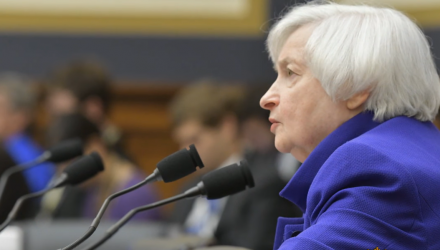The major indexes were awash with red ink last Friday as fears of a global economic slowdown was compounded by market noise of an inverted yield curve blaring from the bond community. To former Federal Reserve Chairman Janet Yellen, this shouldn’t sound the trumpet on a recession, but a rate cut.
“I don’t see it as a signal of recession,” Yellen said during a question and answer session at the Credit Suisse Asian Financial Conference.
Last Friday saw the short-term 3-month and longer-term 10-year yield curve invert, which hasn’t been seen since 2007–just ahead of the financial crisis. This helped send the Dow Jones Industrial Average south by 460 points.
“Could it be that the yield curve is signaling weak global economic growth and low inflation without necessarily implying a recession in the US? We think so, and the US stock market apparently supports our thesis,” Ed Yardeni of Yardeni Research said in his morning note Friday. “So why are global stock markets also doing so well? Perhaps there is too much pessimism about the global economic outlook.”
The spread between the 3-month and 10-year notes fell below 10 basis points for the first time in over a decade. This strong recession indicator contrasted a more upbeat central bank on Wednesday, but investors were quick to sense the cautiousness.
Yellen’s assessment comes after the central bank’s decision to keep interest rates unchanged last week. In move that was widely anticipated by most market experts, the Federal Reserve on Wednesday elected to keep rates unchanged, holding its policy rate in a range between 2.25 percent and 2.5 percent. In addition, the central bank alluded to no more rate hikes for the rest of 2019 after initially forecasting two.
A recurring theme of “patience” was mentioned in Federal Reserve Chairman Jerome Powell’s press conference following the rate announcement. Additionally Powell mentioned that the U.S. economy is in a “good place.”
“The U.S. economy is in a good place,” said Powell. “We will continue to use our monetary policy tools to help keep it there. The jobs market is strong, showing healthier wage gains and prompting many people to join or remain in the workforce. The unemployment rate is near historic lows and inflation remains near our 2 percent goal.”
Fears of a global economic slowdown affecting the markets were on the central bank’s mind.
“Since last year, we’ve noted some developments at home and around the world that bear our close attention,” said Powell. “Given the overall favorable conditions in our economy, my colleagues and I will be patient in assessing what, if any, changes in the stance of policy may be needed.”
Related: Putting Trade into Context: Sage’s Outlook on Emerging Markets
Recently, results from a survey of central bank respondents revealed that gross domestic product is expected to slow to a 2.33 percent rate of growth this year after initially forecasting 2.44 in January.
“The U.S. is certainly experiencing a slowing of growth,” Yellen said.
The 2.33 GDP growth reading is also lower than that of the current growth rate of 3.1 during the fourth quarter of 2018. Things aren’t looking much better for 2020 as survey respondents are expecting GDP to grow under 2 percent.
According to Yellen, however, GDP won’t slow enough to a point where it reaches a recessionary pace.
“So that’s not a dangerous situation,” she said. “So, yes, growth is slowing, but I don’t see it slowing to a level that will cause a recession.”
For more market trends, visit ETF Trends.
